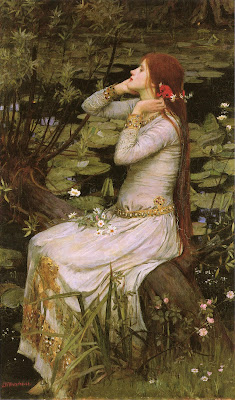**Authentically Human! Not Written by AI**
 |
| Ophelia by John William Waterhouse 1894, oil on canvas, 124.4 x 73.6 cm (49.0 x 29.0 in). Private collection |
 |
| The Lady of Shallot 1888, oil on canvas, 153 x 200 cm (60.2 x 78.7 in). Tate Britain, London |
The model, Muriel Foster, looks somewhat like Siddall, but they were not related or even contemporaries. Siddall died in 1862 from an overdose of laudanum, long before Foster posed for Waterhouse. Many of the women depicted by the PRB look similar. Partly this is because the artists often shared models, but also because they tended to paint an idealized representation of a certain type of female beauty.
Another common aspect of Pre-Raphaelite paintings is a dreamlike landscape bursting with color and texture. Millais stepped beyond reality when he painted his “Ophelia” from life in a garden over seasons in order to capture the full range of blooming plants. But so many of the PRB landscapes seem less than real and more like the backdrop of a stage set.
Here’s an interesting take on this by critic A. Lys Baldry from an article he wrote on Waterhouse in 1895, in which he discusses the difference between painting in the studio and outdoors:
...as outside colour is beyond the reach of the painter in the studio, outside effects of atmosphere are also to be forbidden. On this point, Mr. Waterhouse, most of whose pictures, by the way, are now treated with landscape backgrounds, has equally rational convictions. To paint the conventionalised figures in accordance with the studio theory and to juxtapose with them a realistic landscape would be obviously jarring, and the result would be disjointed and uncomfortable. Therefore, if the setting of the subject chosen for the picture must necessarily be trees and sky, or a blue sea, these details must be in their turn conventionalised and treated as colour masses alone. The land must, in fact, be of the nature of a tapestry backing, real enough in form, accurate as it can be made in drawing and perspective, and possessed of all possible charm and harmony of colour, but without any suggestion of atmospheric variation or change of effect. Of this use of out-of-door material for pictures that have to be painted under a roof, Mr. Waterhouse has given excellent examples in his “Naiad” and “Ophelia,” both of which owe not a little of their refinement and charm of colour to the sensitive treatment of the backgrounds and accessories of leaves and branches.
— from The Studio, An Illustrated Magazine of Fine and Applied Art, Baldry, A. Lys (January 1895), J. W. Waterhouse and his Work, vol. 4, pp. 103–115





















